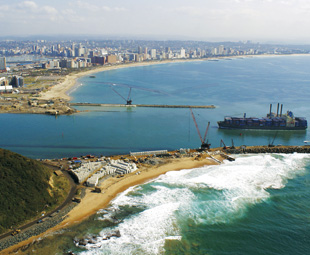SA’s maritime industry: building a better mousetrap?

Sea transport has carried the largest volume of freight throughout recorded history and still plays a vital role in the world economy. JACO DE KLERK discovers what it takes to successfully construct port infrastructure and looks at some exciting developments in the shipbuilding industry.
Construction and upgrades of port infrastructure aren’t for the faint-hearted; the conditions are challenging and the finished product needs to last. “Ports are meant to last for a long time; typically between 50 and 100 years,” explains André van Tonder, divisional director of Coastal and Port Engineering at WSP Africa (a consulting engineering firm).
“It is important that the materials are durable, and planning is appropriate so that the port can be integrated into future developments to accommodate any changes in design of ships and other modes of transport and cargo handling – a port is a link in the supply chain.”
Van Tonder adds that challenges arise during the construction period. “It’s a more difficult construction process, compared to a land-bound project, because you’re working in a wet and dynamic environment with wave action and a changing water level, due to the tide,” he points out. “This could wreak havoc with the construction process,”
He continues: “You need adequate knowledge, background and experience – not every contractor can work in this environment. It requires people who have done this before.”
According to Van Tonder, the planning and design process is very important. The design also has to be appropriate to the harsh environment. It is also important to try to predict the conditions under which the contractor will have to operate. “Downtime has to be planned for as well. Even with the best planning, you seldom succeed in adhering to the original programme and design.” The ocean really is an unpredictable foe.
Van Tonder says that the downtime knock does, however, depend on the amount of work put in beforehand to understand the environment in which the construction is going to take place. “It determines how much you know in advance about the risks that might pop up during the project.”
Here is where WSP Africa can help. Testimony to this is the company’s involvement with Transnet National Ports Authority (TNPA) in reviewing the current ports around the South African coastline and mapping out the implementation of the National Ports Plan (NPP).
The implementation of the NPP outlines key projects – as aligned to the Strategic Infrastructure Projects – spanning over thirty years, which will upgrade the port infrastructure and capacity to meet future predicted demand.
Besides massive growth in infrastructure, development is also taking place in the shipbuilding arena. TNPA’s R1,4-billion contract to produce nine powerful tugboats is progressing on time and within budget at the Southern African Shipyards premises in Durban, one of the largest shipyards in southern Africa.
Two tugs will be allocated to each of the Ports of Durban, Richards Bay and Port Elizabeth, while Saldanha, which handles the largest carriers and has had a history of vessel groundings, will receive three tugs to replace an ageing fleet.
The project kicked off in August 2014 and is set to provide a big boost to the local economy over its 42-month lifespan. (The first tug is expected to be handed over in January 2016 in Port Elizabeth, followed by handovers every three months until the last one is launched in early 2018.)
The project also includes the manufacture of one of the world’s largest and most powerful harbour tugs, which will be 42 m long and
15 m wide with a bollard pull of 100 t. The other eight 31-m tugs are marginally bigger than the existing ones, but are far more powerful, with a 70-t pull. The older tugs have 32,5- to 40-t pulls.
“This is a milestone project that reinforces the capacity and skills available in South Africa, and particularly in Durban, when it comes to competing in the global shipbuilding industry,” says TNPA programme manager Eugene Rappetti, who is also the senior manager for marine operations.
Rappetti adds that TNPA has 29 tugs presently in service nationally, but the requirement for bigger, stronger tugboat fleets has increased in line with bigger commercial vessels calling at South African ports more frequently.
“The increased bollard pull of these new-generation tugs meets international standards. They also feature the latest global technology. The tugs have Voith Scheider propulsion, which makes them highly manoeuvrable and able to change direction and thrust almost instantaneously, while guiding large vessels safely into our ports.”
Prasheen Maharaj, CEO of Southern African Shipyards, adds that his company created 500 direct and 3 500 indirect jobs through the project.
“This is a real demonstration of how the maritime economy can be used to unlock the economic potential of South Africa. Our country definitely has the skills and capacity to succeed in sectors such as marine transport and manufacturing, ship building and ship repair,” Maharaj points out.
The economic benefits don’t stop there, however. Maharaj explains: “We have committed to ensuring that each tug has a minimum of 60-percent locally manufactured components, while partnering with international companies on the remaining aspects that cannot be manufactured here – for example, the engines and propulsion units.”
Maharaj emphasises that South Africa will ultimately achieve a socio-economic benefit of more than R800 million as a result of the supplier development plan attached to the contract.
In addition, a number of national and international training and development opportunities are being created for local employees, with TNPA already set to send employees to Germany and Norway for training on the new propulsion units. They will also receive training locally for four to six weeks.
Rappetti adds that TNPA also has a large training programme in place for engineering and deck cadets to ensure that the vessels have skilled people in place to operate them.
It would seem that sea transport isn’t only a leader when it comes to carrying freight, but that it is also a major carrier of the South African economy. Doesn’t that just float your boat?
Published by
Focus on Transport
focusmagsa




 Big news from FOCUS on Transport + Logist
Big news from FOCUS on Transport + Logist


 !
Starting 1 April, every
!
Starting 1 April, every


 FUSO: Driving the Future of Mobile Healthc
FUSO: Driving the Future of Mobile Healthc



 A brand
A brand




 Wondering about the maximum legal load for a
Wondering about the maximum legal load for a 
 The MAN hTGX powered by a hydrogen combus
The MAN hTGX powered by a hydrogen combus

 Exciting News for South African Operators
Exciting News for South African Operators


